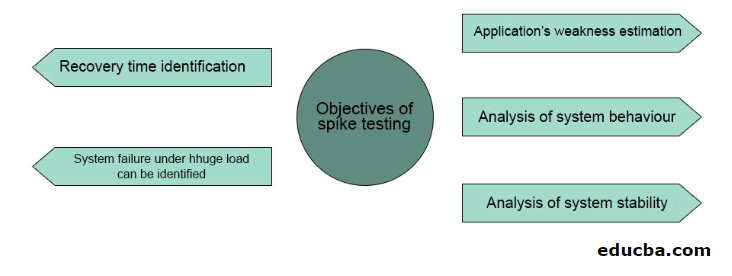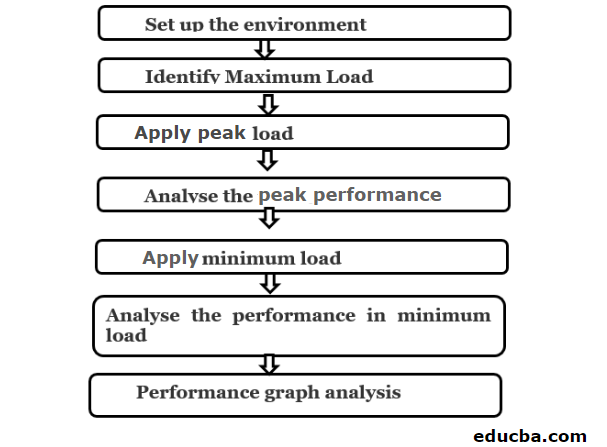
Introduction on Spike Testing
Testing is a vital part of the Software Development Life Cycle (SDLC) that checks various software components such as scalability, speed, and stability. Some of the testing techniques are stress testing, load testing, volume testing, endurance testing, compatibility testing, spike testing, and so on. These testing methods ensure that the developed software works fine under the expected workload and several other scenarios. Hence, the software testers are able to offer the product owners necessary information regarding scalability, accuracy, speed, and stability.
What is Spike Testing?
Spike Testing is performance testing, which is also a subset of stress testing that ensures whether the software or application developed is working under rapidly increasing and decreasing load generated by users. It is to make sure that no issue won’t arise in the speed of software, stability, and scalability after the product’s delivery.
The main objectives of this Software Testing are:
- Estimates the applications’ weaknesses.
- The behavior of the system can be analysed.
- The stability of the system is analysed when there is a burst of load
- System’s failure under huge load can be observed.
- Identify the recovery time between the spike [Spike is the rapid decrease and increase in traffic] of increasing and decreasing the load.
While performing a spike test, the performance of the application may get worsen, slows or stops entirely. At that time, testers may find it and determine the point where the application or software fails. This can help in rectifying the mistakes of the developer while developing for the production environment.
How to do Spike Testing?
Steps to perform spike testing are:
The process to do spike testing is explained in the below section.
1. Set up the environment
Make sure that a live environment is not used and a separate testing environment is used to perform spike testing in an application. Set up the testing environment based on the several parameters in the business requirement.
2. Identify Maximum Load
Identify the maximum load capacity of the software or application you have developed.
3. Apply peak load
Use any tools or softwares to apply the maximum expected load. Increase the load rapidly for a certain period of time.
4. Analyse the peak performance
Analyse the performance of the application in the maximum load.
5. Apply minimum load
Reduce the load gradually to the minimum level.
6. Analyse the performance in minimum load
Analyse the performance of the application in the minimum load.
7. Performance graph analysis
Performance graph analysis is done by considering the metrics such as Time taken, virtual users, failures etc. This will help the testers in identifying where the application has undergone failure and reporting the developers to fix the issue based on that.
Now, let us see some of the advantages and disadvantages of Spike Testing.
Advantages
Below are some of the advantages.
- Since performance is analysed even in extremely high load and extremely low load, issues won’t arise in the real environment. In these scenarios, it is helpful.
- Consequences of unexpected changes in load are addressed.
- Maintains the system from crashing under spikes of the load.
- Normally, worst-case scenarios won’t be addressed in the standard testing method. But through spike testing, all these issues are addressed.
- Identify how much an application or software can perform past its expected load.
- Developers are able to avoid application crash since the problems are identified.
Disadvantages
Following are the disadvantages given.
- Expensive since it needs special test conditions.
- Independent testing environment is needed.
- The time needed is more compared to other testing methods.
Tools Used
All the performance testing tools can be used for Spike Testing. But some tools are commonly used apart from others. They are:
-
Apache JMeter
Apache JMeter is an open-source tool that is 100% java application designed to functional test the performance and behaviour. Caching, full multi-threading, highly extensible core, portability, offline analysis are the main features of Apache JMeter.
-
Loadrunner
LoadRunner is an expensive software testing tool from Micro Focus which is used to perform under load, measure behaviour of the system, test applications. It can simulate a large number of users at the same time using application software. It records the same and later analyses the application’s key component performance.
As of now, we had discussed what is Spike Testing, its process along with advantages and disadvantages. Now, let us see some recovery scenarios we can use in Spike Testing.
- Try to use cloud platforms such as Microsoft Azure, Amazon Web Services (AWS), etc. to rapidly increase the capacity of the server in synchronization with the user load.
- Do not give permission to access the software or application for some users. In this way, people above the peak load cannot enter the application. This can protect the system from excess load threat.
- Try to provide a warning message to the user who enters the system. Then he or she will be able to perform based on that.
Some of the Spike Testing scenarios are addressed below.
- When an online store is launching special offers with huge discount on special days.
- Web Application is Live streaming a popular.
- Exam result published on a website.
- When a particular website goes viral for its content.
- Multiple users access the system when it is newly released.
- Login the system after a power outage issue is resolved.
- Service outage of a system
Conclusion
It is a performance testing where an increase and decrease in spike is applied to an application or software developed. It helps in identifying the maximum load and common issues that can arise when an increase in load is applied. Process, advantages and common bugs regarding this testing is explained in the above sections.
Recommended Articles
This is a guide to Spike Testing. Here we discuss basic concept, step by step process along with the advantages and disadvantages. You may also have a look at the following articles to learn more –


